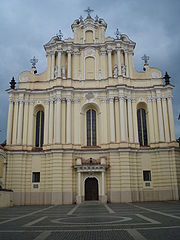
Johann Christoph Glaubitz
Encyclopedia

Architect
An architect is a person trained in the planning, design and oversight of the construction of buildings. To practice architecture means to offer or render services in connection with the design and construction of a building, or group of buildings and the space within the site surrounding the...
of German
Germans
The Germans are a Germanic ethnic group native to Central Europe. The English term Germans has referred to the German-speaking population of the Holy Roman Empire since the Late Middle Ages....
descent who is generally considered to be the most prominent Baroque
Baroque architecture
Baroque architecture is a term used to describe the building style of the Baroque era, begun in late sixteenth century Italy, that took the Roman vocabulary of Renaissance architecture and used it in a new rhetorical and theatrical fashion, often to express the triumph of the Catholic Church and...
architect in the lands of the former Grand Duchy of Lithuania
Grand Duchy of Lithuania
The Grand Duchy of Lithuania was a European state from the 12th /13th century until 1569 and then as a constituent part of Polish-Lithuanian Commonwealth until 1791 when Constitution of May 3, 1791 abolished it in favor of unitary state. It was founded by the Lithuanians, one of the polytheistic...
.
Glaubitz was born in Schweidnitz (Świdnica)
Swidnica
Świdnica is a city in south-western Poland in the region of Silesia. It has a population of 60,317 according to 2006 figures. It lies in Lower Silesian Voivodeship, being the seventh largest town in that voivodeship. From 1975–98 it was in the former Wałbrzych Voivodeship...
, Silesia
Silesia
Silesia is a historical region of Central Europe located mostly in Poland, with smaller parts also in the Czech Republic, and Germany.Silesia is rich in mineral and natural resources, and includes several important industrial areas. Silesia's largest city and historical capital is Wrocław...
, and spent the first 37 years of his life there. After a devastating fires occurred in 1737 in Vilnius
Vilnius
Vilnius is the capital of Lithuania, and its largest city, with a population of 560,190 as of 2010. It is the seat of the Vilnius city municipality and of the Vilnius district municipality. It is also the capital of Vilnius County...
, he was called to rebuilt Lutheran St. Johns' Church, which in 1555 had been funded by German merchants.
Glaubitz, who was among the leaders of the Lutherans community of Vilnius, is credited for developing a distinct Lithuanian school of Baroque architecture, known as Vilnian Baroque, which is best reflected in the cityscape of the Old Town of Vilnius. This has contributed to the widespread naming of Old Vilnius as the "City of Baroque".
There are at least four churches in Vilnius reconstructed by Glaubitz, namely the Church of St. Catherine (1743), the Church of the Ascension (1750), the Church of St. John, the monastery gate and the towers of the Church of the Holy Trinity. The magnificent and dynamic Baroque facade of the formerly Gothic
Gothic architecture
Gothic architecture is a style of architecture that flourished during the high and late medieval period. It evolved from Romanesque architecture and was succeeded by Renaissance architecture....
Church of St. Johns (1749) is mentioned among his best works. Many church interiors including the one of the Great Synagogue of Vilna
Great Synagogue of Vilna
The Great Synagogue of Vilna which once stood at the end of Jewish Street , Vilna, Lithuania, was built between 1630-1633 after permission was granted to construct a synagogue from stone...
were reconstructed by Glaubitz as well as the Town Hall in 1769.
A notable building by Glaubitz was the former Carmelite church of Hlybokaye
Hlybokaye
Hlybokaye is a town in Vitebsk Oblast, Belarus, the capital of the Hlybokaye Raion . The first records about the settlement are dated 1514....
, Belarus
Belarus
Belarus , officially the Republic of Belarus, is a landlocked country in Eastern Europe, bordered clockwise by Russia to the northeast, Ukraine to the south, Poland to the west, and Lithuania and Latvia to the northwest. Its capital is Minsk; other major cities include Brest, Grodno , Gomel ,...
, which he reconstructed in 1735; it is now the Orthodox Church of the Birth of Theotokos
Theotokos
Theotokos is the Greek title of Mary, the mother of Jesus used especially in the Eastern Orthodox, Oriental Orthodox, and Eastern Catholic Churches. Its literal English translations include God-bearer and the one who gives birth to God. Less literal translations include Mother of God...
. Other towns with architecture by Glaubitz include Mahilyow, Lida
Lida
Lida is a city in western Belarus in Hrodna Voblast, situated 160 km west of Minsk. It is the fourteenth largest city in Belarus.- Etymology :...
, and the Cathedral of Saint Sophia in Polatsk in Belarus and Daugavpils
Daugavpils
Daugavpils is a city in southeastern Latvia, located on the banks of the Daugava River, from which the city gets its name. Daugavpils literally means "Daugava Castle". With a population of over 100,000, it is the second largest city in the country after the capital Riga, which is located some...
in Latvia
Latvia
Latvia , officially the Republic of Latvia , is a country in the Baltic region of Northern Europe. It is bordered to the north by Estonia , to the south by Lithuania , to the east by the Russian Federation , to the southeast by Belarus and shares maritime borders to the west with Sweden...
. The Church of St. Peter and St. Paul in Berezovichi, now part of Hlybokaye, was built in 1776 and demolished in the 1960s and 1970s. Its replica was constructed in Białystok in the 1990s.
Primary sources
- S. Lorentz, Jan Krzysztof Glaubitz - architekt wileński XVIII wieku, Warszawa 1937

